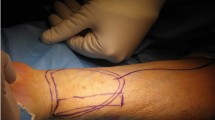Abstract
The purpose of this study was to investigate the effects of two different types of pedicle manipulation two weeks prior to harvesting of flow-through venous flaps (FTVF). The dorsal aspect of the ear of New Zealand white rabbits was used in the investigation. Two different delay procedures (manipulation of pedicle) were performed and compared to the single stage harvesting of FTVF. In the first delay (arterial ligation group), the central artery was ligated at the proximal and distal edge of the flap, and the flap was harvested after two weeks. In the second delay (arteriovenous shunt group), the central artery was anastomosed to the lateral caudal vein at the proximal part of the ear to create an arteriovenous shunt and to increase blood flow in the venous system. The FTVF was again harvested two weeks after the creation of the arteriovenous shunt. The survival rates and the superficial flap necrosis rates of the two different delay groups were compared to the nondelayed group.
The mean survival of the arterial ligation group (82%) and the arteriovenous shunt group (80%) show significantly increased survival when compared to the nondelayed group (44%). The superficial flap necrosis rates in the two delay groups were also decreased when compared to the non delayed group.
Similar content being viewed by others
References
Washio H (1971) An intestinal conduit for free transplantation other tissues. Plast Reconstr Surg 48:48
Erol 00, Spira M (1981) Utilization of a composite island flap employing omentum in organ reconstruction: an experimental investigation. Plast Reconstr Surg 68:561
Shintomi Y, Ohura T (1982) The use of muscle vascularized pedicle flaps. Plast Reconstr Surg 70:725
Erol 00 (1976) The transformation of a free skin graft into a vascularized pedicle flap. Plast Reconstr Surg 58:470
Hori Y, Tamai S, Okuda H, Sakamoto H, Takita T, Masuhara K (1979) Blood vessel transplantation to bone. J Hand Surg 4:23
Erol 00, Spira M (1980) New capillary bed formation with a surgical constructed arteriovenous fistula. Plast Reconstr Surg 66:109
Nakayama Y, Soeda S, Kasai Y (1981) Flap nourished by arterial inflow through the venous system: an experimental investigation. Plast Reconstr Surg 67:328
Suzuki Y, Suziki K, Ishikawa K (1994) Direct monitoring of the microcirculation in experimental venous flaps with afferent arteriovenous fistulas. Br J Plast Surg 47:558
Reinish J (1974) The pathophysiology of skin flap circulation: the delay phenomenon. Plast Reconstr Surg 54:324
Inada Y, Hirai T, Fukui A, Omokawa S, Mii Y, Tamai S (1992) An experimental study of the flow-through venous flap: investigation of the width area of the survival with one flow-through vein preserved. J Reconstr Microsurg 8:301
Noreldin AA, Fukuta K, Jackson IT (1992) Role of perivenous areolar tissue in the viability of venous flaps: an experimental study on the inferior epigastric venous flap of the rat. Br J Plast Surg 45:21
Takato T, Komuro Y, Yonehara H, Zuker RM (1993) Prefabricated venous flap: an experimental study in rabbits. Br J Plast Surg 46:125
Ueda K, Harada T, Nagasaka S, Oba S, Inoue T, Harashina T (1993) An experimental study of delay of flow-through venous flaps. Br J Plast Surg 46:59
Xiu ZF, Chen ZJ (1996) The microcirculation and survival of experimental flow-through venous flaps. Br J Plast Surg 49:45
Byun JS, Constantinescu M, Lee A, May JW (1995) Effects of delay procedures on vasculature and survival of arterialised venous flaps: an experimental study in rabbits. Plast Reconstr Surg 96:1656–1657
Author information
Authors and Affiliations
Rights and permissions
About this article
Cite this article
Çelik, M., Jackson, I.T., Çelebiler, Ö. et al. The effects of two different delay phenomena in flow-through venous flaps. Eur J Plast Surg 21, 43–46 (1998). https://doi.org/10.1007/BF01152423
Received:
Accepted:
Issue Date:
DOI: https://doi.org/10.1007/BF01152423




